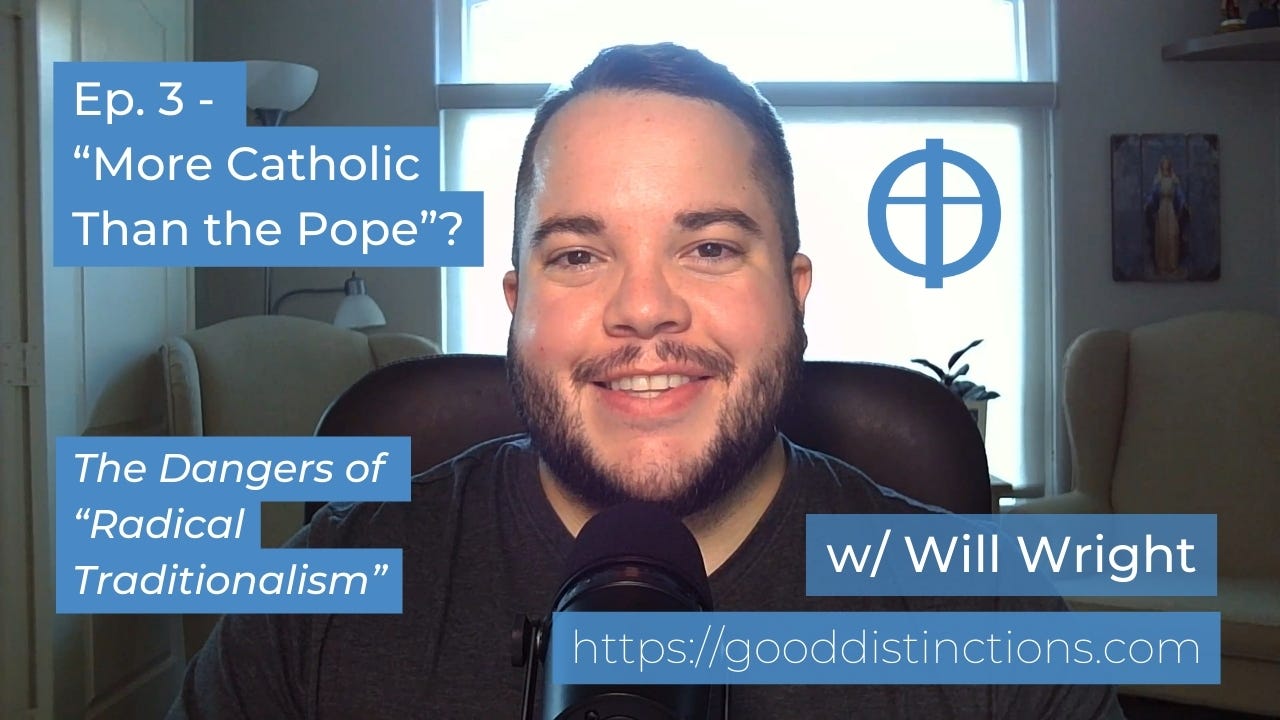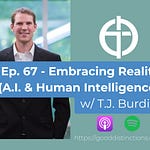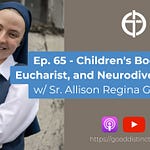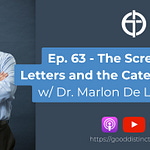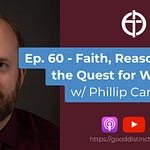NOTE: This article from May 2023 was fairly popular, so I decided to record it for YouTube and for the Podcast streams. Enjoy, and please comment, like, and share!
Introduction
This is not an article refuting various theological points of the Society of St. Pius X. It is not an extensive refutation of the pernicious errors of sedevacantism. What it aims to be is a reiteration of what the Church Herself is, who we are in relationship to Her, and a warning to avoid the grave sin of schism.
The Church of Jesus Christ is the Catholic Church. This Church is visible and clearly manifest. Jesus is not trying to trick us. God, our Father, desires our salvation. The Holy Spirit guides and guards the Church. Our Blessed Mother never ceases to intercede for us. No matter how bleak things seem, staying in the Barque of Peter is always the best option.
What is the Church of Jesus Christ?
During the Second Vatican Council in the 1960s, the Council Fathers took up the task of writing a Dogmatic Constitution (the highest magisterial level of a Church document) on the Church Herself. The Mystery of the Church is expounded in this constitution: Lumen Gentium. Promulgated by Pope St. Paul VI in November 1964, the Council Fathers provided a clear and beautiful description of Holy Mother Church.
Found in paragraph 8 of Lumen Gentium, in particular, is a nuanced and gorgeous explication of the Church. Passages such as these must be read in continuity with everything that came before this moment in the Church or we run the risk of reading it outside of the heart and mind of the Church. One word, especially, provides difficulty for some readers of Lumen Gentium: “subsists.” However, I hope to show, in short order, that this word is inspired. The paragraph begins:
“Christ, the one Mediator, established and continually sustains here on earth His holy Church, the community of faith, hope and charity, as an entity with visible delineation through which He communicated truth and grace to all. But, the society structured with hierarchical organs and the Mystical Body of Christ, are not to be considered as two realities, nor are the visible assembly and the spiritual community, nor the earthly Church and the Church enriched with heavenly things; rather they form one complex reality which coalesces from a divine and a human element. For this reason, by no weak analogy, it is compared to the mystery of the incarnate Word. As the assumed nature inseparably united to Him, serves the divine Word as a living organ of salvation, so, in a similar way, does the visible social structure of the Church serve the Spirit of Christ, who vivifies it, in the building up of the body (LG, 8; emphasis added).”
Let us pause here for a moment. To summarize: Christ is the one Mediator between God and man and the Church which He established and continually sustains is His Church. In a strongly analogous sense, the Church is both human and divine because there is a visible structure but an internal cohesion as well.
The passage continues:
This is the one Church of Christ which in the Creed is professed as one, holy, catholic and apostolic, which our Saviour, after His Resurrection, commissioned Peter to shepherd, and him and the other apostles to extend and direct with authority, which He erected for all ages as ‘the pillar and mainstay of the truth.’ This Church constituted and organized in the world as a society, subsists in the Catholic Church, which is governed by the successor of Peter and by the Bishops in communion with him, although many elements of sanctification and of truth are found outside of its visible structure. These elements, as gifts belonging to the Church of Christ, are forces impelling toward catholic unity.”
If we understand that Jesus Christ, our Lord and Savior, founded a Church two thousand years ago, then we can acclaim rightly that this Church is divinely constituted. As the Church has always affirmed, the Church is the Mystical Body of Christ. This Church is visible. As Lumen Gentium, this Church IS the one Church of Christ professed in the Creed. So, why do folks have a problem with the phrase “subsists in?” Generally, it is due to a suspicion of the Second Vatican Council that sees the modernist boogeyman in every page of the documents of this Council.
The Latin phrase used “subsistit in” is actually quite ancient, the meaning going back at least to the terminology of Aristotle. It means to exist as a substance. In other words, the Church was founded by Christ and has been sustained by Him as one, true, substantive thing. This one Church is the Catholic Church. So, why not just say is (est in Latin)? Well, not to belabor the point, but they did! The first part of the paragraph containing “subsistit in” begins: “Haec est unica Christi Ecclesia (this is the one Church of Christ).” The Council Fathers are not disputing the understanding of the Catholic Church as the Church of Jesus Christ.
The Church of Jesus Christ can be encountered as a concrete subject only in the Catholic Church. The “elements of sanctification and of truth” outside the visible structure of the Church are the reality that God is present and operative in the Sacraments, such as Baptism and Matrimony, in Protestant communities and present and operative in all seven Sacraments in the Orthodox Churches. Nonetheless, the Church subsists only in the Catholic Church. These elements of sanctification are not substantial and concrete instantiations of the Church of Jesus Christ apart from the Catholic Church, rather they are an admittance that moves as He wills and is drawing all people to Himself in the Catholic Church. This is true ecumenism: being willing instruments in helping the Holy Spirit guide all persons to the truth and fullness of the Catholic Church, which is visible and concrete.
To take another approach, we could say that when God effects a Sacrament or moves in grace and power outside the visible bounds of the Catholic Church, it is nonetheless a fact that “the one Church of Christ has an operative presence in them (Ut Unum Sint, 8),” as St. John Paul II wrote. So, if someone is saved by sacramental grace, it is still only by the grace flowing from the one true Church of Jesus Christ which is the Catholic Church, our sacrament of salvation on Earth.
How Can We Identify the Catholic Church?
The Catholic Church has always been visible, though admittedly clandestine in certain circumstances. We can think here of the difficult situation in China today or of the Church in Communist nations in the 20th Century. Or we can look at England under the reign of Queen Elizabeth I. Or under Roman persecutions or Muslim occupations. Nonetheless, the Church was founded by Christ and continues to be sustained by Him and guided and guarded by the Holy Spirit.
The four marks of the Church are present in fullness in the Catholic Church: one, holy, catholic, and apostolic. The Church is one because Christ is one. In the inner life of the Trinity, there is no disunity. Likewise, the Church cannot have disunity, as it is the Mystical Body of Christ. The Church is holy because Christ is holy, though it is composed of sinners. The Church is catholic because it is universal (Greek: katholou - “according to the whole”). God desires the salvation of all and our Blessed Lord commissioned the Apostles to preach the Gospel to the ends of the Earth. This apostolicity finds fruition not only being built upon the successors of the Apostles, but it is also firmly set on apostolic teaching. As a result, the Church has a true unity of governance, preaching, teaching, and means of sanctification.
The Catholic Church has a visible hierarchical structure. The successors of the Apostles are the bishops of the Catholic Church - this is historically provable. However, apostolic does not only mean the successors of the Apostles exist. If that were the case, then the Orthodox Churches would rightly be considered apostolic. However, apostolicity also requires the recognition that Jesus designated Peter as the Prince of the Apostles. The Papacy is the succession of this Petrine office. The teaching authority of Christ passed on to the Apostles, the Magisterium, is thus the successor of Peter in union with all the successors of the Apostles. In other words, it is the Pope in union with all the bishops of the world.
The Church of Jesus Christ will thus be one, holy, catholic, and apostolic. It will have a visible hierarchy of the Pope, bishops, priests, deacons, religious, and lay people. Just as a body, the Church will have a metabolism, an internal means of sustenance, as well. This is clearly the Holy Eucharist: the Body, Blood, Soul, and Divinity of Jesus Christ hidden under the veil of a sacrament. There will be actual church buildings. There will be assemblies of the faithful. The visible Catholic Church will be manifest and clear to all who seek Her out, because Jesus is not trying to trick us.
What is Radical Traditionalism?
Finally, with a working understanding of what is meant by the Church of Jesus Christ and the Catholic Church, we can turn our attention to “radical traditionalism.” Granted, this is a term which means as many different things as “conservative” and “liberal” do in American politics.
My usage of the term is pragmatic, more than descriptive. A Catholic ought to be traditional, in the fullest sense of the term. A Catholic also ought to be radical, in the sense that radical comes from the Latin radix meaning “root.” We are rooted in Jesus Christ, and apart from Him we can do nothing.
The Southern Poverty Law Center associates Radical Traditionalism with white supremacy, anti-immigrant attitudes, and anti-Semitism. Though there is some correlation in reality between radical traditionalist communities and these ideologies, there is no causation. In general Catholic circles, the main characteristic of radical traditionalism is not only a preference for the Latin Mass according to the Missale Romanum of 1962, but a tacit (if not explicit) rejection of the Roman Missal of 1970 (called the “Novus Ordo”). Further, “radical traditionalists” reject the Second Vatican Council, usually in its entirety. They see it as heretical nonsense, unfaithful, and a divergence from the true Faith.
The term “radical traditionalist” is often wrongly associated with thrown around against those who attend the Holy Mass with the Priestly Fraternity of St. Peter (FSSP), the Institute of Christ the King Sovereign Priest (ICKSP), and other communities in full and complete union with Rome. This needs to stop. These communities are obedient to the Holy Father and their local ordinary. They do not reject Vatican II or the Novus Ordo. They have a deep love and reverence for the Vetus Ordo (the Old Order of Mass and the Sacraments) and have permission to celebrate the Sacred Liturgy according to that charism. Simply having a preference for the Latin Mass does not make someone a “radical traditionalist.”
Radical Traditionalism is a rejection of Catholicism, underneath the veneer of a heroic savior-complex of safeguarding Tradition against the Modernists. Now, I want to be clear: Modernism is a serious problem in the Church and the world today. Pope St. Pius X referred to Modernism as the synthesis of all heresies. Ultimately, it is a denial of the supernatural and of mediation. This liberalizing tendency should be fought tooth and nail, without doubt! But what we cannot do is reject the Second Vatican Council, deny the legitimacy of the Novus Ordo, or choose to be disobedient to the competent authority.
What is Sedevacantism?
One of the loudest voices within radical traditionalism (at least on Twitter) is sedevacantism. Sede means “seat” in Latin and vacante means “empty.” Sedevacantists believe that due to formal heresy, the sitting pope lost the papacy. Usually, these groups will maintain that Pope Pius XII was the last valid pope, others will make arguments for Pope John XXIII and I have even heard one argument for Pope Paul VI (though this one makes the least sense).
Mario Derksen of “Novus Ordo Watch” in his talk “Eclipse of the Church: The Case for Sedevacantism” on October 8, 2021 lays out his arguments. I do not intend to litigate them here, but I will share part of the conclusion of his talk:
“If Francis and his five predecessors of unhappy memory were true Popes, then the forces of darkness would indeed have prevailed. Then the ‘most deadly foes of the Catholic religion,’ as Pope Pius IX called them, would have triumphed, then the ‘proud gates of hell’ would have succeeded in overthrowing the Chair of Truth and turning it into a fount of blasphemy and heresy. Then what had been the ‘citadel and bulwark of the Catholic faith’ would have become the bulldozer of Catholicism.”
So, for the sedevacantist, none of the Popes since Pope Pius XII have been true Popes. For those who are curious, that would be since 1958. For the last 65 years, the Members of the Body of Christ have been misled en masse, according to this view. Further, with virtually all of the cardinals, bishops, and priests complicit in this great apostasy, how are we to restore the Church to its former glory?
Again, I do not intend to debate sedevacantism here because, frankly, I think the position is so intuitively absurd that it would be a waste of time to do so. If Mario Derksen is being honest about his own conclusions, he would likely agree. In the paragraph directly before what I have already quoted, he says:
“Yes, we are happy to call it ‘Sedevacantism,’ but it really isn’t an ‘-ism’ other than Catholicism during these perplexing times. It is a theological position that ‘creates itself’, as it were, after we’ve ruled out the things we know to be impossible in light of the timeless truths of the Catholic Faith. Sedevacantism is what is left once we have rejected what is clearly false.”
In other words, in the face of the entire Mystical Body of Christ on Earth, including five legitimately elected Popes, the sedevacantist chooses to trust his or her feelings rather than trusting that the Holy Spirit guides and guards the Church. I cannot think of anything more modernist than that.
However, I will be honest. I am sympathetic to the sedevacantist view. We do live in troubling times. The Popes of recent memory, even the amazing St. John Paul II and the incredible Pope Benedict XVI, have made some strange choices and prudential decisions. Further, many bishops and priests have said and done horrifically scandalous things without any sense of justice of discipline meted out by the Church. But this is not an excuse to abandon reason and play the hero who is “preserving” the Church precisely by leaving it. Because, make no mistake, sedevacantism is formal schism.
Though there are many independent sedevacantist churches, the most prominent are the Roman Catholic Institute (RCI), Most Holy Family Monastery (MHFM), Society of St. Pius V (SSPV), St. Gertrude the Great Church in Cincinnati, Ohio, and the Congregation of Mary Immaculate Queen (CMRI). If you want a more substantive refutation of Sedevacantism, I would recommend this fantastic resource from Noah Perez at Catholicism Coffee entitled “3 New Arguments Against Sedevacantism.”
What is the Society of St. Pius X (SSPX)?
In this article I want to outline some of the dangers of radical traditionalism. This article would get far too broad if I began refuting various points or getting into the nitty gritty. Those resources exist. My goal, again, is only to show some of the spiritual dangers posed by sedevacantist and non-sedevacantist radical traditionalists.
The largest group of “radical traditionalist Catholicism” is the Society of St. Pius X (SSPX). Officially, the SSPX is not sedevacantist. They acknowledge the legitimacy of the Roman Pontiff and his predecessors. However, they reject the Second Vatican Council because they believe it contains theological errors and heresy. They reject large parts of the 1983 Code of Canon Law. Over half of priests and most of the original and current leadership of SSPX reject the New Mass as containing elements dangerous for the Faith.
Since the days of Archbishop Marcel Lefevbre, they have conducted illicit ordinations of bishops and priests and consecrations. The Society has even discouraged its followers from attending the Latin Mass offered by priests in full and manifest union with Rome because of the belief that these ordinations are deficient because they were conducted by a revised rite.
The website of the Society of Saint Pius X claims that “no canonical censures against the SSPX have ever existed (SSPX).” They also claim that the “persecution” of the SSPX is political in nature and that any notions of excommunication and schism are “false accusations.” To the contrary, Pope St. John Paul II through the Prefect of the Vatican’s Congregation for Bishops publicly decreed on July 1, 1988 that Archbishop Marcel Lefevbre and the four new bishops he consecrated illicitly had incurred the penalty of excommunication. The legitimacy of these excommunications was further clarified and reiterated by the Vatican in 1996 and 1998.
More recently, Pope Benedict XVI and Pope Francis have made great strides in attempting to normalize the canonical status of the SSPX. Admittedly the level of ambiguity of their current canonical status among informed and very bright Catholics is puzzling to me. What is clear to me, though, is the spirit of disobedience that runs rampant through the SSPX. For example, the SSPX do not believe that they are in Schism (or ever were) nor do they believe that Archbishop Lefebvre was excommunicated (he was and that excommunication has not been lifted). Their reasoning can be found on their own website archives:
“No penalty is ever incurred without committing a subjective mortal sin (canons 1321 §1, 1323 70). Now, Archbishop Lefebvre made it amply clear that he was bound in conscience to do what he could do to continue the Catholic priesthood and that he was obeying God in going ahead with the consecrations (Cf. the Sermon of June 30, 1988, and Archbishop Lefebvre and the Vatican, p. 136). Hence, even if he had been wrong, there would be no subjective sin (SSPX).”
Archbishop Lefevbre believed, erroneously, that if he did not gravely disobey the Pope, then the Catholic priesthood would not continue. And they say that this was not a mortal sin; actually, they say that it was no sin at all. There are recent books that continue this line of thinking, such as SSPX “apologist” Kennedy Hall’s new defense of the Society. This thinking is ridiculous and insidious. For a more sufficient refutation of this line of reasoning, I would recommend this 2008 article on the excommunications from Cathy Caridi, J.C.L. of Canon Law Made Easy.
The disobedience of the SSPX is insidious because they believe they are the saviors of Catholicism and that they alone are safeguarding Tradition from the Modernist Church. However, unlike the sedevacantists, they still acknowledge the rightfully elected Pope and his authority. They simply choose to be disobedient. In some regards, this position is even less tenable and less sympathetic than full-blown sedevacantism.
The SSPX has significantly more faculties under some of the allowances granted by Pope Francis. Pope Francis gave priests of the SSPX faculties to validly and licitly absolve sins; this is a faculty granted by the local ordinary regularly. They were also granted faculties to witness Holy Matrimony validly and licitly. Those within the Society argue that this shows that they are not in schism and they are in union with Rome. I think it says more about Holy Mother Church’s care for souls who are currently under the care of the Society than it does about the priests and leadership of SSPX. These are not canonical changes; they are indults (extension of legal authority in an action that the Church does not sanction).
The reality is that the SSPX is not in full communion with the Catholic Church, they have no canonical status in the Church, and they are in schism (just as the Orthodox Churches are in schism). There is an excellent compilation of references by prominent clergymen about the reality of schism of the SSPX by no less than Cardinals Burke and Mueller here.
A Schismatic Spirit is Deadly
The Church of Jesus Christ is the Catholic Church, which is One, Holy, Catholic, and Apostolic. Sedevacantism and positions such as that of the SSPX do harm to each of the four marks of the Church. The clear and manifest schism of sedevacantism is a wound to all four marks of the Church, but so is the ambiguous and insidious schismatic spirit of the SSPX.
The Church of Jesus Christ is one, with Christ as Head and we as Members of His Mystical Body. This is an invisible reality but it is also clearly visible and hierarchical. As a Catholic, to reject the Vicar of Christ as the head of the Church on Earth is to reject Christ Himself. It is to cut off oneself from the Church. Of course, we pray for reconciliation and unity! As long as someone has breath in their lungs it is not too late to repent and return. However, we need to understand that schism is a grave evil on the same canonical level as formal heresy and apostasy. To leave the Barque of Peter in times of turbulent water is a misguided plan.
Yes, times are difficult. Yes, the Church is in crisis. But Jesus Christ is not in crisis. He is asleep on the bench as the waves and wind rock and batter the boat. He is with us and all we need to do is call upon Him; He will calm the raging sea. Instead, if we trust in our own power, we will drown. If we make ourselves the authority, we will be doing the will of the Enemy rather than the Holy Will of the Father. If we are to love Christ and His one, true Church then we must avoid radical traditionalism and every sense of a schismatic spirit with a holy fervor. Noone knows better than Holy Mother Church. Times are tough. But the Church of Jesus Christ is the one place to be. A schismatic spirit is deadly to the soul.
As St. Augustine said: “Bad times, hard times, this is what people keep saying; but let us live well, and times shall be good. We are the times: Such as we are, such are the times.”



